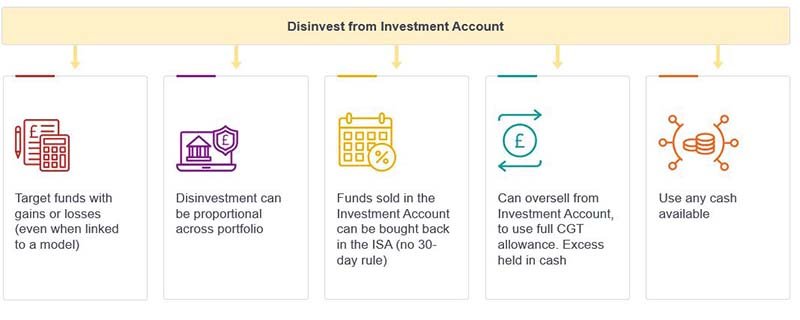
In this article, I’m going to talk through the flexible options you have when moving money from a client’s Investment Account to their ISA.
The first step is to identify clients that are able to undertake this exercise, if appropriate. The quick and easy way is to run a report across your business showing all your clients with an unused ISA allowance and who have money held within an Investment Account. This report is called the ISA Contribution report and can be found via the ‘Reporting Services’ section of our website.
The Bed & ISA process is fully automated. A single submission includes both the disinvestment instruction from the Investment Account and the investment instruction into the ISA with the proceeds. What’s more, the buying and selling options are very flexible.
If we look at the sell side first:
- You can sell specific funds, regardless of whether the account is linked to a model portfolio, which may be useful for targeting capital gains or losses. Our unrealised gains report may help here, which I cover in a separate article.
- Or, if there are no capital gains issues, you may want to sell proportionally across the portfolio.
- The funds you sell within the Investment Account can be bought back within the ISA without any implications as regards the 30-day rule. We make this easy for you – simply tick the appropriate box when completing the online process. The only exception to this is where the ISA is linked to a model portfolio, as the proceeds will be invested as per the model allocation. However, if you wish to adopt a different strategy, you can open a new ISA account as part of the process.
- You can elect to oversell as part of the Bed & ISA process. So, while we can only move £20,000 into an ISA, you may wish to sell more than this to utilise the client’s full capital gains tax allowance, for example. Any excess over £20,000 will be held in the Product Cash Account. This may also be useful where you are looking to top up the client’s Cash Management Account for fees, as this money can then be moved from Product Cash to the Cash Management Account. The Investment Account must be in a client’s sole name in order to do this.
- Finally, you can use any cash held within the account before selling any funds.

Within the ISA, you can:
- Buy back the same funds sold from the Investment Account.
- Invest in a different strategy from the one within the Investment Account, so this could be a model portfolio or discretionary model portfolio service.
- You can rebalance the existing ISA funds at the same time. This might be useful if you are changing the investment strategy for the whole account.
- You can open a new ISA if you want to adopt a different investment strategy for this year’s allowance. For example, the client may want to reduce risk and invest into some of the cash funds available on the platform.
A key point to note is that we don’t wait for settlement of the sell deals before we invest the money. Once all the sell deals have been priced, we will place the buy instructions. This limits the time out of the market for the client.

Finally, where the ISA holder is not a holder of the Investment Account, you will need to use the ' Bed & ISA for a third party form'.
You will also need the clients owning the source Investment Account and the target ISA to complete and sign a Deed of Gift form which should be returned with the Bed & ISA third party form. If you submit via Upload and Send you should use the ‘Instruction Form’ Section for the Bed & ISA third party form and upload the Deed of Gift form as a supporting document.
More useful information on our Bed & ISA facility can be found within the Help and Support area of our website (login required). In addition, you may find the other articles in this series helpful when administering client accounts – these touch upon practical tips for pension planning, practical capital gains management, tax-efficient fee funding and using the ISA allowance in uncertain times.
Important information
The value of investments and the income from them can go down as well as up so your client may get back less than they invest. This article provides information and is only intended to provide an overview of the current law in this area and does not constitute financial advice, tax advice or legal advice, or provide any recommendations. The value of benefits depends on individual circumstances. The minimum age clients can normally access their pension savings is currently 55, and is due to rise to 57 on 6 April 2028, unless they have a lower protected pension age. Different options may have different effects for tax purposes, different implications for pension provision and different impacts on other assets and financial planning.
UKM0424/386671/SSO/0325
Practical tips for pension planning
In this article, I’d like to highlight the information available that can ass…
Practical capital gains management
In this article, I’d like to highlight some of the reporting available that c…
Tax-efficient fee funding
In this article, I’m going to look at deducting fees from ISA and General Inv…

